GET TO KNOW THE S.S. UNITED STATES DECK BY DECK
Click on the above cutaway diagram to see the ship broken down by class of passenger accommodation.
Click on the above cutaway diagram to see the ship broken down according to our restoration and adaptive reuse plan.
Click here to read a breakdown of the restoration plan
The Navigation Bridge and Top of Houses
(Click on the deck plans to expand them to full size)
Deck plan as built and as proposed
Explanation of Recommendations
Sports Deck.
Deck plan as built
Deck plan as proposed
Promenade Deck
Promenade Deck as built
Promenade Deck as proposed
Upper Deck as built
Upper Deck as proposed
Main Deck as built
Main Deck as proposed
A Deck as built
A Deck as proposed
B Deck as built
B Deck as proposed
C Deck as built
C Deck as proposed
D Deck as built
D Deck as proposed
E Deck as built and as proposed
The Hold as built and as proposed
- svg]:stroke-accent-900">

“The S.S. United States: America’s New Superliner”
By C. B. Palmer
Posted on Dec 5, 2014 1:18 AM EST
8 minute read
This month the waters of the Atlantic Ocean will feel for the first time the smooth rush of something very special in the way of superliners. The S.S. United States will be taking her builder’s trials and acceptance trials preparatory to entering the deluxe transatlantic trade on July 3.
For the first time in 75 years this country has built a competitor in the top-speed bracket. The entirely mythical “blue riband,” denoting the holder of the record for the fastest passenger ship crossings of the Atlantic, has been in European hands for a century. In a sense this has been a matter of default; American ship operators in recent years have not chosen to enter the competition for many reasons. We have built many fine and popular ships—highly comfortable and of good speed—but not ships designed to travel at the 30-knots-and-above necessary to make record passages and headlines. The United States is definitely in this field.
Beyond that there are other toppers about this ship. She is the largest passenger vessel this country has ever built—51,500 gross tons. Operated by a 1,000-man crew, she will carry more passengers than any other American-built ship—nearly 2,000. She is fireproof beyond any standard ever set by any commercial vessel under any flag. She is air-conditioned throughout—all public rooms, cabins, crew quarters. She uses more aluminum than any other single structure ever built, land or sea. It is used structurally and for decoration and furnishings.
Usually, such technical matters do not strike the eye of the beholder or customer. But those who board the United States for her maiden voyage and for trips thereafter will sense the new qualities. At dockside she shows all the bigness of her 990-foot length, her 10 1/2-foot beam and her 13-story height above the waterline. Yet there is a lightness and easiness about her lines. The bow springs forward not sharply but cleanly and in harmony with the bulk behind it. The white superstructure and the great stacks lie easily on the sleek black hull.
Step aboard this ship and both your eyes and your feet tell you there’s something different about her. On the open decks you expect the “plock” of teak decks underfoot and the feel of teak rails under your hands. But there’s no teak. The decks are a brand-new mastic composition spread over aluminum or steel. The rails are long sections of extruded aluminum, glossy under a special finish. And the decks are remarkably open, swept free of all possible protrusions and fittings, with few ups and downs. The overhead is sheeted smoothly in metal to conceal beams and pipes that would be eyesores.
The same inside. The corridors are long straightaways, with few jogs and turnings and with the usual plumber’s nightmare all out of sight. Many of the public rooms extend the full width of the ship. There are many pieces of art on American themes, some in metal or glass—no wood is used in the ship itself. There are screens of glass sculpted by sandblasting. There is a plaster relief map of the North Atlantic. There are aluminum panels anodized to give them soft colors. There are four-foot sculptures carved out of foam glass.
Furnishings Retard Fire
Fabrics and wall finishes run the whole spectrum, but both fabrics and paints are fire-retardant. Furniture is aluminum; upholstery and cushions are springy and soft but they are filled with a new material that will not flame.
For those who must take their shore side fun to sea with them there are all the facilities. There are two smart theaters for movies and other entertainment. There are swimming pools, lounges, restaurants, nightclubs, libraries, barbershops, beauty parlors, gift shops—all the things that go into a modern luxury liner. There is even a special refrigerated room for the storage of those bon voyage baskets!
For the athletic-minded, there are sports decks—topside, forward and aft—plus a gym and indoor pool. Enclosed promenade decks sweep along the sides. Cabins range from four-in-a-room for tourists to suites up to five rooms in first class. Cabin class—524 passengers—and first class—888 passengers —have private baths; in tourist class—554 passengers—the baths are shared. The cabins have a wide range of color schemes—soft tones and bright, worked out in contrasts, a far cry indeed from the dead whites and “institutional” colors familiar not so long ago.
Can Be Converted into Troop Transport
Despite the ship’s charms for pleasure travelers, she was built with very different auxiliary purposes in mind. In time of war the United States would become a troop transport, capable of carrying a full Army division. Accordingly, Uncle Sam, who has provided part of the financing, is keeping some of the secrets about her. Her compartmentation—the number and location of watertight bulkheads with their automatic doors—is not being told.
Details of the power plant also are shielded by security. Certain things, however, are evident about the punch in the United States . Here is a ship of 51,500 gross tons, as against the 80,000 or so of the Queen Elizabeth and the Queen Mary . Yet this ship will carry almost as many passengers as the Queens and will carry them as fast. This means that important space has been gained somewhere, and it’s a good guess that it has been gained in boiler room, engine room and fuel storage.
The boilers and turbines operate at very high temperatures and high pressures. To handle these in the small space and weight called for new tricks by the metallurgists who worked out the alloys and by the fabricators who designed and built the machinery. In the laboratories and shops of the Newport News Shipbuilding and Dry Dock Co., which built the vessel, and of Westinghouse and Babcock & Wilcox, which built the engines and machinery, technicians took all that was known about marine propulsion and added a few new items.
Air Conditioning a Problem
The air conditioning was a highly desirable feature but its headaches were many. Finding space for the pumps, fans, ducts and controls was one of them. There are really 50 independent air-conditioning systems, and their ducts range in size from three inches to some that are big enough to drive a truck through. And once fitted in— on paper—there still remained the problems of building them and making them work.
The space problem was one for the designers. As fast as they cleared a blueprint it went to the sheet-metal shops at Newport News and the men began cutting out and assembling the fantastic shapes that had to carry the air around corners and up and down in the ship. Subassemblies were made as large as possible and stacked up on the dock. There they looked like the principal ingredient of alphabet soup—and in a foreign language at that. But they were fitted in place and hooked up.
Making the air-conditioning systems work was a special problem. Air conditioning at sea offers different problems than on land. There is more moisture in the air most of the time; there are greater contrasts of temperature inside and out. The problem of condensation was severe. It was solved by insulation and by using filter traps at intervals all along the ducts. These collect the moisture in a few spots rather than let it accumulate anywhere on the surface of the ducts. Another feature of the system is the thermostatic control in each cabin. All the air, filtered from the outside, is circulated in the ship at 50°. When it reaches a cabin it passes through an electric heating unit controlled by the thermostat; the passenger in an outside cabin may want more heat, one in an inside may want more cooling. Each will get what he wants.
Aluminum Was Tricky
The use of so much aluminum, in so many ways, called for new tricks. Plain sheet was no problem, and some shapes could be stamped, molded or extruded. But when it came to the stacks it was economic folly to think of shaping them with dies and presses. The heavy sheets could not be worked like steel, with rollers or torches and hand hammers, because aluminum just won’t shape that way. It had to be worked slowly and carefully by hands and clamps and special jigs. And when the stacks were done they were so big they had to be cut in half to be lifted into place.
The aluminum rails were turned out to approximate dimensions, including all the curves and fittings, in the shops of the Aluminum Co. of America. Then they were put in place, with precise machining, on the ship. Next they were marked, removed and shipped back to Alcoa for “alumilite” coating, the final finishing process. And then they were sent back to the ship for permanent installation.
Aluminum panels and decorations had to go through much the same laborious process. Aluminum rivets were handled like trick confectionery. Received from the factory, they were first heated to 1,040°, to “smooth out” the alloys, then quenched in water and rinsed in alcohol. To prevent the rapid aging which takes place at ordinary temperatures, the rivets were sunk in freezer cabinets at 40° below zero. Thereafter they were stored in insulated containers (including standard ice-cream cabinets) until they were driven. Once in place the aging, which results in greater strength, could take place.
The virtue of all this aluminum topside is of course its lightness. Averaging one third the weight of steel, it lowers the ship’s center of gravity, in turn reducing her tendency to roll.
Behind all these innovations is the genius and drive of a man generally considered the country’s No. 1 naval architect. He is William Francis Gibbs of the New York firm of Gibbs & Cox. Designer of the America, the country’s largest passenger ship now in service, and other major merchant craft as well as many types of naval vessels, he has for many years advocated such a supership as the United States —in the top class for speed, completely fireproofed, air-conditioned, luxurious. It took a lot of persuading, over the years. But his dream began to turn to reality on April 7, 1948, when the Government’s Maritime Commission and the United States Lines agreed on a financing plan and the Newport News yard was given the word to go ahead with the construction. The original contract price was a little under $70,000,000; modifications at the behest of the Government have raised that figure considerably.
For its money the nation has a lot of ship to show. In peacetime the United States will maintain its North Atlantic express run and few doubt that it will take a shot at the record now held by the Queen Mary —3 days 20 hours and 40 minutes, eastbound. All this means prestige and patronage. In wartime the ship, as the nation’s largest transport, could carry 14,000 to 16,000 troops as far as 10,000 miles without a stop. Peace or war, a lot of ship.
Read the original story in the_ Popular Science _archives, and see how the United States _looks today ._
Latest in Military
See the b-21 nuclear stealth bomber’s first official flight photos see the b-21 nuclear stealth bomber’s first official flight photos.
By Andrew Paul
Space Force finds a dead Cold War-era satellite missing for 25 years Space Force finds a dead Cold War-era satellite missing for 25 years
Hildreth Meière Documentary Series - Watch Trailer
- List by Name
- List by State
- List by Type
- List by Year
- Newspaper Features
- Selected Publications by Hildreth Meière
- Unpublished Articles by Hildreth Meière
- Selected Pre-1961 Articles About Hildreth Meière
- Dissertation
- Published Photographs of Hildreth Meière's Studies
- Book Illustrations by Hildreth Meière
- Radio Interviews
- List of Past Lectures
- Contact IHMA
- Receive Digital Updates
- Major Collaborators
- Archival Collections
- Exhibitions
- Recent Books
- Recent Articles
- Recent Newspaper Features
- Favorite Quotations from Hildreth Meière
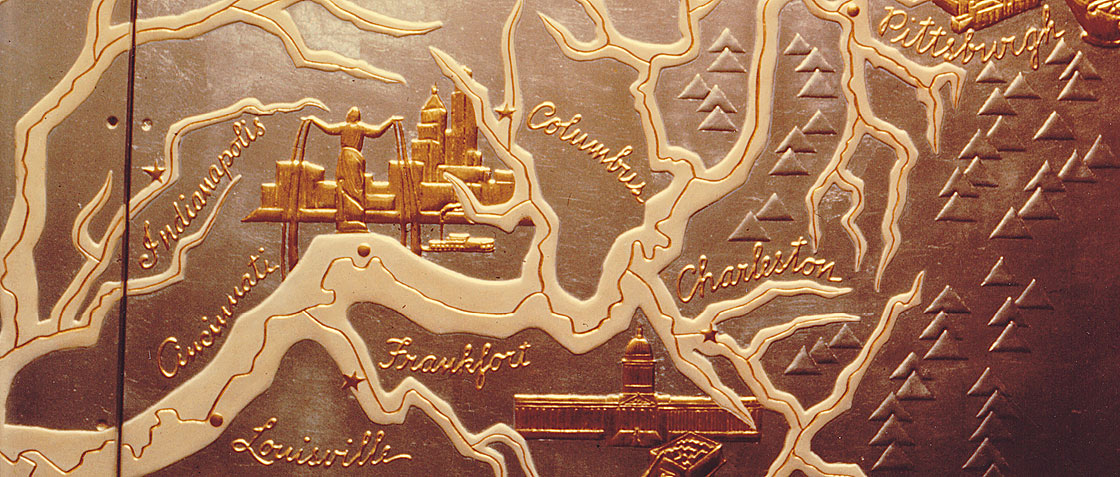
Ocean Liners: S.S. United States
Cabin class lounge wall map, the mississippi, father of waters , 1952.
Commissioned by : Smyth, Urquhart & Markwald Medium : gesso and metal relief Executed by : Louis Ross Relocated to : National Museum of American History, Smithsonian Institution
Related Commissions:
- S.S. America
- S.S. African Comet
- S.S. President Monroe
- S.S. Brazil
- S.S. United States
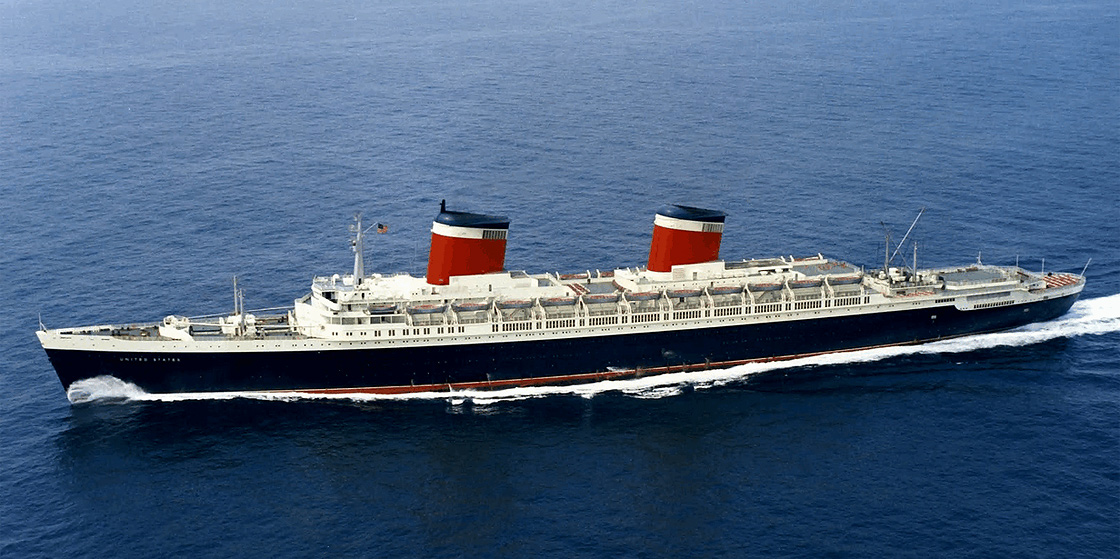
S.S. United States under sail
When she was designed, the S.S. United States was a ship of superlatives. Partially financed by the Navy and designed by Gibbs & Cox, she was the fastest ship ever built in America and also the safest. Constructed to be lightweight and fireproof, the rivets, railings, interior walls, and lacquered furniture were all constructed in aluminum. In addition, the entire ship was air conditioned.
The all-female interior decorating firm of Smyth Urquhart & Markwald hired Hildreth Meière and Austin Purves as consultants to create an art program and select artists to decorate the S.S. United States in a manner that would best represent the country. This was the second time Meière worked with them. In 1939 the firm had commissioned Meière to design decoration for another Gibbs & Cox ship, the S.S. America .
According to the press release issued by the S.S. United States :
Homogeneity in the entire decorative arts scheme of the great ship was desirable, they felt, and in order to achieve it within the fireproof and weight limitations, the supervisory help of the two artists in this particular phase seemed essential. Accordingly, in addition to contributing work of their own, Mrs. Meière and Mr. Purves advised the decorators in the selection of other artists and also served in a critical capacity on the work submitted. 1
Among the artists whom Meière and Purves selected to decorate the ship were Louis Ross, Gwen Lux, Peter Ostuni, Charles Lin Tissot, William King, Charles Gilbert, and Raymond Wendell:
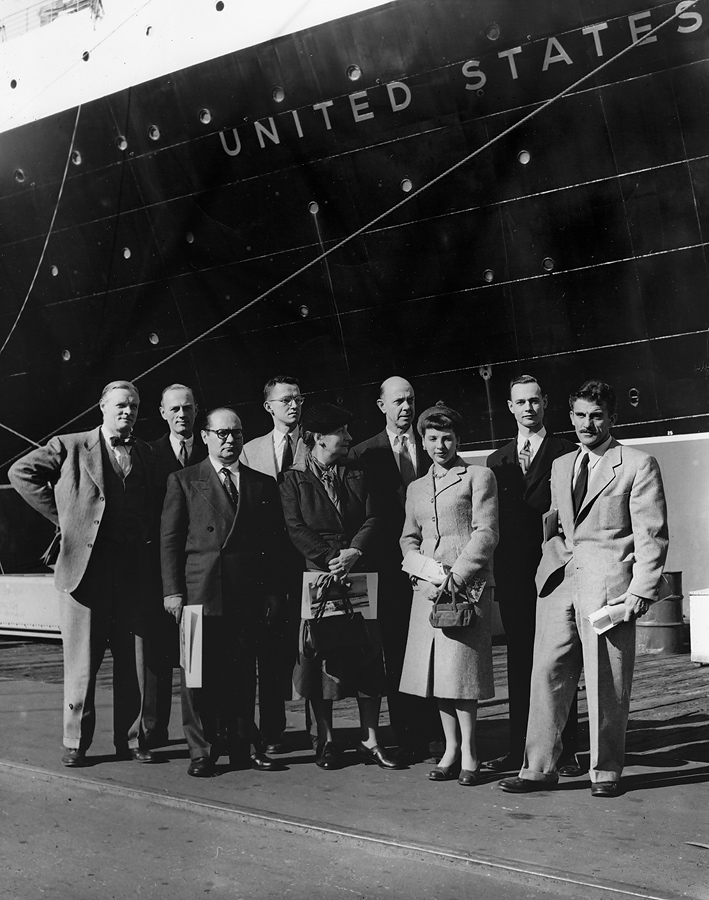
Front row, left to right: Louis Ross, Hildreth Meière, Gwen Lux, Peter Ostuni; back row, left to right: Austin Purves, Charles Lin Tissot, William King, Charles Gilbert, Raymond Wendell
The decorating firm issued a statement about the importance of “character” in the work by the various artists:
Because the unquestioned beauty of the [S.S.] United States is the result of her honest expression of function, it was decided that it was this ‘character’ rather than any ‘style’ which was to be striven for, and the artists have approached their work as individuals through their media and the nature of the subject matter, rather than through any conscious idiom, ‘conservative’ or ‘modern.’ 2
Smyth, Urquhart & Markwald also chose an American decorative theme:
The overall theme chosen for decorative art was a reflection of life in the United States appropriate to the greatest ship ever produced in this country. Emphasis was to be on Americana and the natural elements. Consequently such subjects as the Mississippi River, Navajo Indian sand painting, old American glassware, aquatic life along the country’s shores, and figures symbolic of the American philosophy were selected. 3
To comply with the requirement that the artwork be fireproof, the artists worked in the mediums of glass, metal, and enamel. 4
In addition to her role as a consultant on design and color, Meière created a mural, The Mississippi, Father of Waters , for the forward wall of the cabin class lounge. The “tree-shaped” map represented Meière’s sixth commission to decorate an ocean liner. It was executed by Louis Ross in white and gilded raised gesso on silver leaf panels, with the names and symbolic representations of cities along the branches of the Mississippi indicated in gold relief: 5
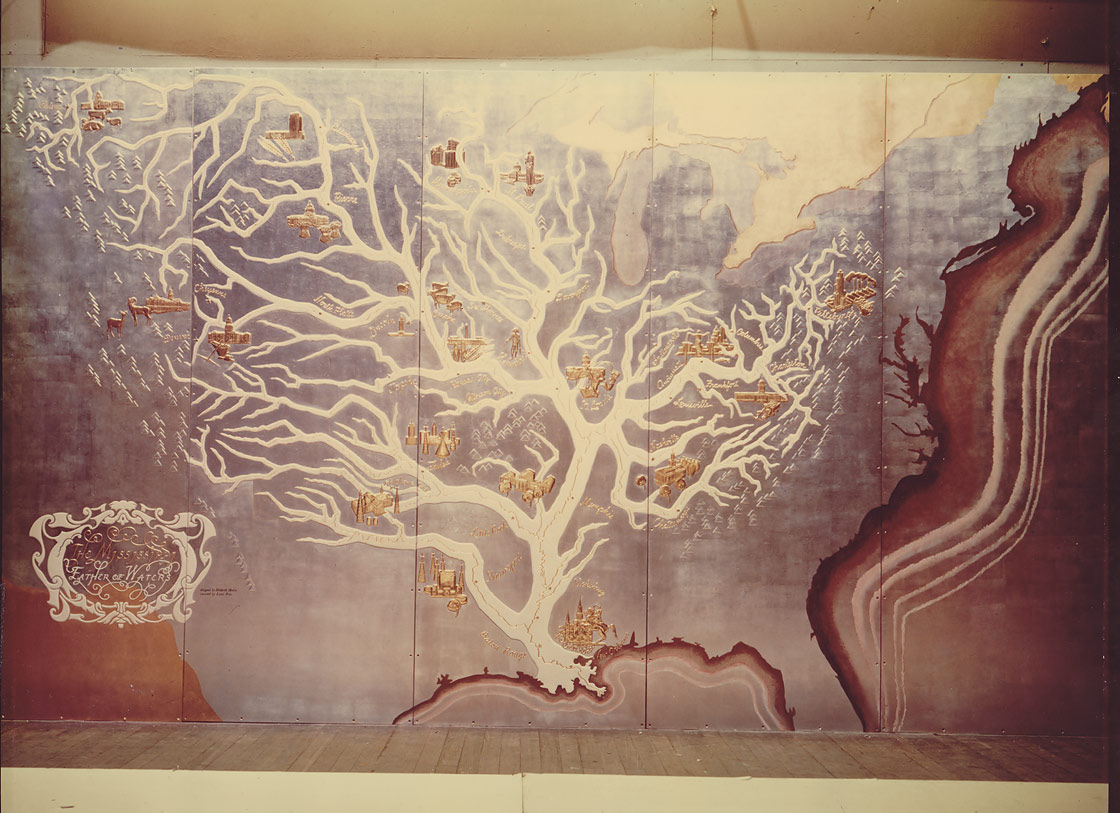
The Mississippi, Father of Waters prior to installation
William E. Blewett, executive vice president of the Newport News Shipbuilding and Dry Dock Company where the S.S. United States was built, explained how the artists’ decoration of the aluminum wall panels was handled:
. . .we have to tool and fit the panels and get them into place, and then take them all out and ship them off to the decorators for their murals and other art treatments. . . . Then they come back and must be reinstalled. 6
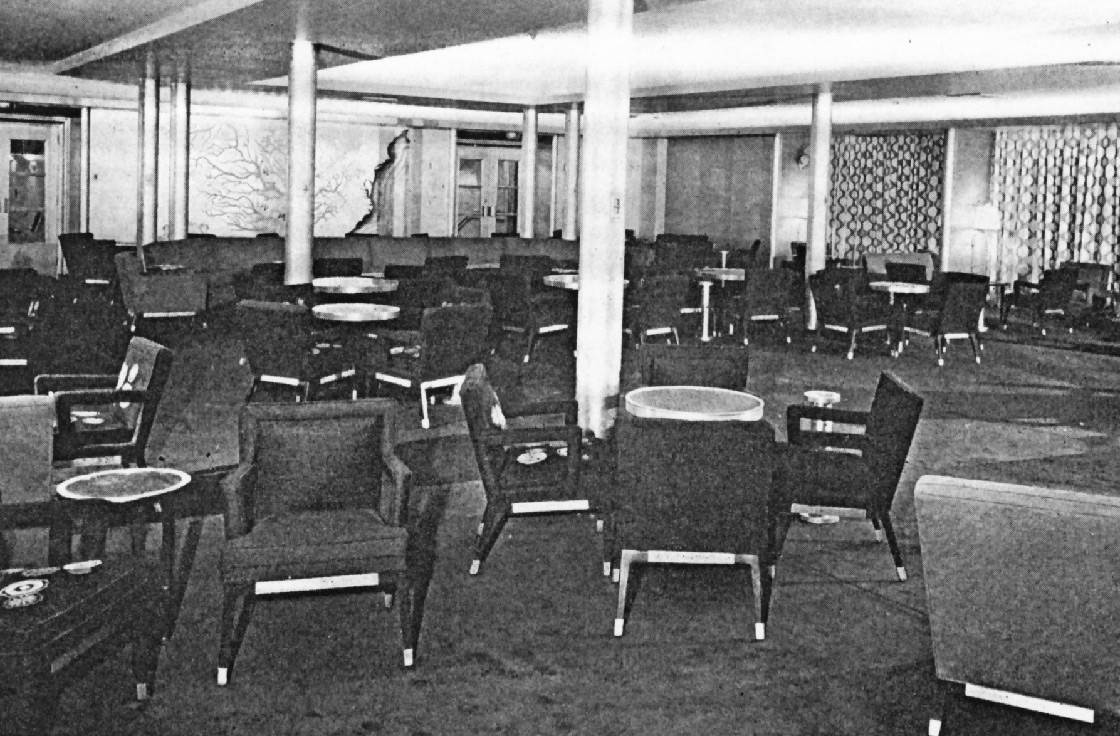
Cabin class lounge with Meière’s Mississippi, Father of Waters
The completed cabin class lounge had aluminum-leaf wall panels, five of which were decorated in silver leaf with Meière’s map of the Mississippi:
The walls of the cabin class lounge are finished in aluminum leaf with a pinkish beige transparent glaze, while various shades of solid red have been used for the larger upholstered pieces. Curtains are modern damask in pink-beige and off-white and a gun metal carpet covers the floor which has a stage at one end, and a 17 by 26 foot dance floor in the center section. A mural designed by Hildreth Meière depicts the Mississippi and its tributaries. Lighting is chiefly indirect and on dimmers, with some concealed lighting of the curtains, bracket lamps and down lighting of the decorative panel. 7
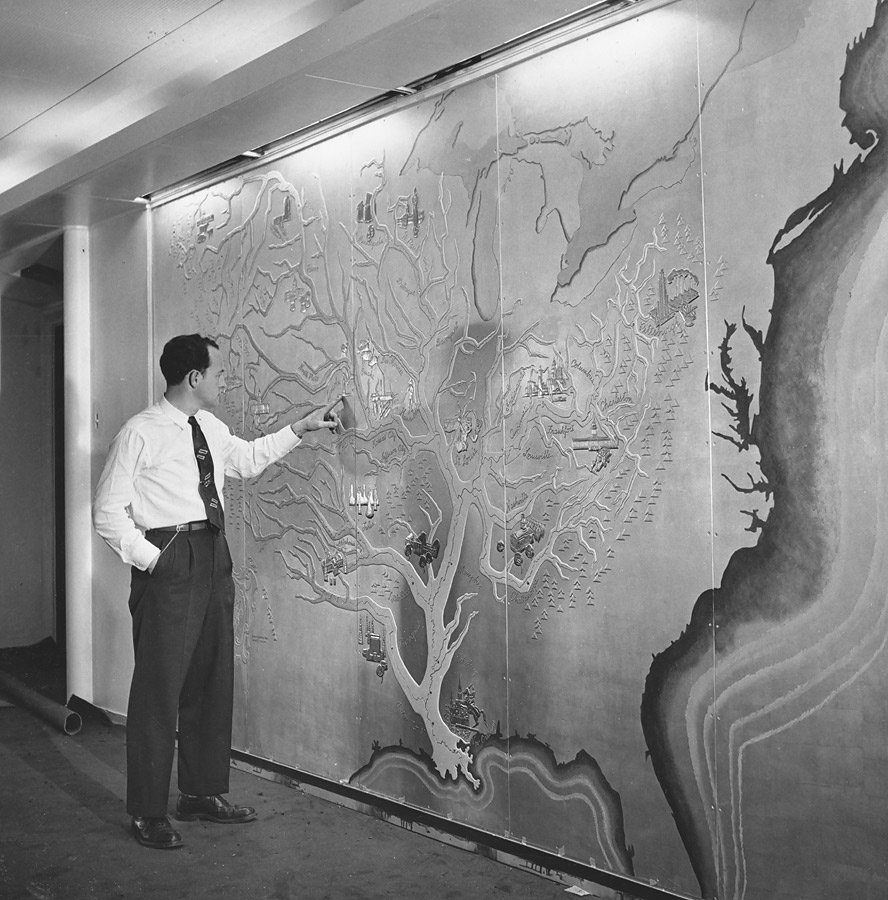
The Mississippi, Father of Waters during installation, with lighting in place
The S.S. United States was taken out of service in 1969 and is currently docked at Pier 82 in Philadelphia. Structurally sound, the ship is maintained by the S.S. United States Conservancy, a not-for-profit dedicated to the reuse and redevelopment of the liner.
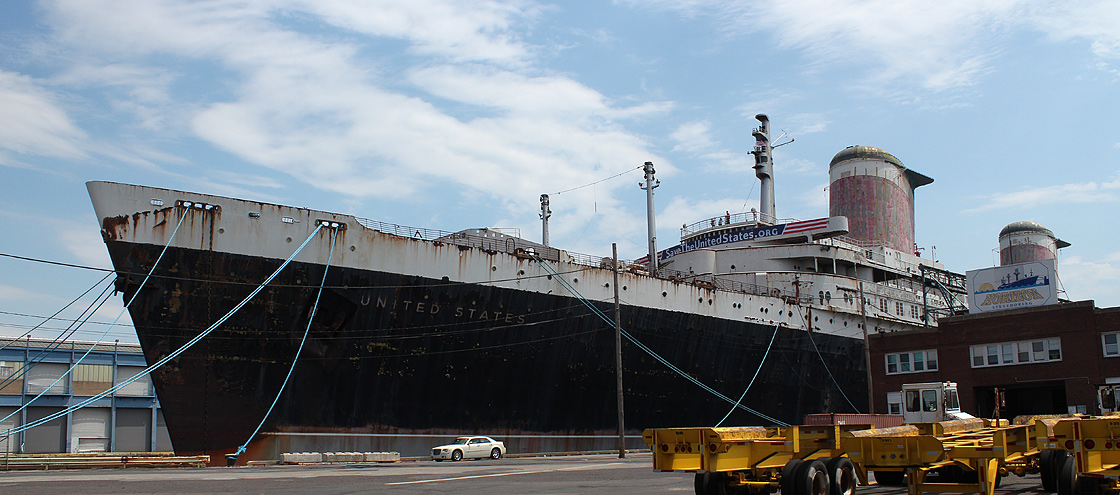
S.S. United States at Pier 82, Philadelphia, PA
Meière’s Mississippi , Father of Waters has been relocated to the National Museum of American History. At some point the map was repainted in shades of green with red highlights, and it no longer represents Meière and Ross’s original design and gilding. The map is not on public view.
“S.S. United States Press Release,” April 30, 1952, p. 3, Hildreth Meière Papers, Archives of American Art, Smithsonian Institution, Washington, DC.
Smyth, Urquhart & Markwald, “ S.S. United States; Consultants on Art Program ,” unpublished description, 1952, Hildreth Meière Papers, Archives of American Art, Smithsonian Institution, Washington, DC.
“S.S. United States Press Release,” p. 3.
“Liner’s decor designed by women,” interview of Hildreth Meière in an Australian newspaper, September 1952.
“ S.S. United States Press Release ,” p. 5 and interview of Meière, September 1952.
George Horne, “3,100 on 3 Shifts Rush Superliner For Her Maiden Voyage on July 3,” New York Times , January 17, 1951.
“For the Cabin Class Traveller,” S.S. United States Issue, Shipyard Bulletin 10 (May-June 1952): 18.
Additional Resources
- S.S. United States Conservancy
National Geographic content straight to your inbox—sign up for our popular newsletters here

A new dawn may be coming to the SS United States , the fastest ocean liner ever, which has been tied up at a pier in Philadelphia since 1996. The ship is 990 feet long, more than a hundred feet longer than the Titanic.
The World’s Fastest Ocean Liner May Be Restored to Sail Again
Tied to a pier in Philadelphia for 20 years, the rusted, stripped, but still majestic S.S. United States could return to service as a luxury cruise ship.
In July 1952, on its maiden voyage, the S.S. United States shattered the record for the fastest crossing of the Atlantic by a passenger ship, steaming from New York to Le Havre in less than four days. In 1969, when it went into dry dock in Newport News, Virginia, and its crew members left their belongings in their cabins, not knowing they’d never sail on it again, it still held the record. And it still does today—though it’s been retired for nearly 47 years, and motionless at a pier in Philadelphia for nearly 20.

On the enclosed promenade deck, first-class passengers once strolled and lounged in deck chairs. First class was at the center of the ship, where the motion was gentlest; cabin class was at the stern and tourist class at the bow.
“The ship is a little worse for wear,” Susan Gibbs said not long ago as we toured the rusting hulk. She is the granddaughter of the ship’s designer, William Francis Gibbs. “But it’s important to keep in mind that she was so overbuilt, she’s still structurally sound. The bones are solid. So it’s not a pipe dream to imagine she could be resurrected.”
On February 4, Crystal Cruises announced that it had signed an option to purchase the ship from the S.S. United States Conservancy , the nonprofit that Gibbs directs. Crystal—a subsidiary of a cruise-and-resort company called Genting Hong Kong —plans to spend this year studying the feasibility of restoring the United States as a luxury cruise vessel, which could cost as much as $700 million. In the meantime it will pay the $60,000 or so a month it costs to maintain the ship.

In the first-class dining room you can still see the stanchions that fixed the tables to the floors. On the back wall there was a sculpture of nymph-like figures representing the Four Freedoms.
Last fall those monthly costs were threatening to doom the great ship to a sad fate: hauled out by its anchor chains onto some Texas beach and scrapped. “I thought she was going down,” said Gibbs. But the Conservancy launched a last-ditch appeal that brought new interest and enough cash from the ship’s many fans to allow it to hang on a few more months. Against all odds, it now has a chance to return to sea. The ship’s age will make that a challenge; all sorts of standards have changed.
Among the Conservancy’s FAQ on the ship, I found this entry: “How do I research whether one of my ancestors traveled on the S.S. United States ?” Since I myself crossed the Atlantic three times on the ship, that shivered my timbers a bit.

Paint is peeling in great shards all over the ship, but at the stern, the railing is also bashed in. An accident happened when a crane was removing one of the propellers some years back.
If the United States were a building, it would be a National Historical Landmark. If it were an airplane, it would be in the Smithsonian. Because it’s an ocean liner—and surely one of the most beautiful, with its gracile lines and stacks swept back as if by the wind—it’s tied up at a pier on the Delaware River, between freighters offloading fruit and cocoa. When you stand on its bow today, you gaze not at foaming Atlantic breakers but across Christopher Columbus Boulevard at a Longhorn Steakhouse and a Lowe’s home improvement store.
“Why does this nation forget its historical accomplishments?” Gibbs mused as we took refuge in the Longhorn restaurant from a blustery January day. “Why is this ship languishing in obscurity?”

In the first-class ballroom, imagine cocktail tables and red barrel chairs surrounding the linoleum dance floor, which is still there. The bar isn’t original; it was brought in a few years ago for a movie shoot.
Through the venetian blinds we could see its blade-like bow, ready to slice across traffic into our booth. The shape of the hull below the water line was one of the secrets of the ship’s tremendous speed—and it was a military secret, as the United States was designed to be converted into a troopship in time of war (though it never was).
Classified too, until the 1970s, were the ship’s four, 18-foot bronze propellers. They were designed by an engineer named Elaine Kaplan. According to A Man and His Ship , a biography by Steven Ujifusa , William Francis Gibbs couldn’t quite comprehend that an attractive woman could be an excellent engineer—but he prized excellence above all else, and so he lived with that paradox.

Looking straight at the bow highlights the ship’s slender lines, which were made possible in part by the light-weight aluminum superstructure.
Gibbs himself, though he designed one of the greatest ships of the 20th century, as well as 2,700 Liberty ships during World War II, had no formal training in his craft. After getting a law degree from Columbia University, he’d lasted only a year as a lawyer. But he’d been drawing ships since 1894 when, as an eight-year-old boy, he’d watched the launch of a 550-foot steamship, the S.S. St. Louis, in the Delaware River, a few miles upriver from where the United States now floats.
In 1913, in his father’s attic, he began drawing what nearly four decades later would become the United States —a 990-foot ship intended, Ujifusa writes, “to be the fastest and best ever built, intended to surpass the ill-fated Titanic in every respect.” It was the year after the iceberg incident.

This way to tourist class (just kidding). A service ladder descends into the bowels of the ship near the stern.
Decades later, when Gibbs finally got the chance to design his ship in reality, he divided it into 20 watertight-compartments so a mere iceberg couldn’t sink it. He made it close to fireproof—he’d watched the Normandie burn and capsize at the pier in Manhattan—in part by using no wood on board except in the Steinway grand pianos. And he made it lightweight by building almost the entire superstructure of aluminum, giving it a power-to-weight ratio the seas had never seen.
In sea trials the United States broke 38 knots. On its record-setting maiden voyage, operating at two-thirds of full steam, it averaged more than 35 knots, four knots faster than the Queen Mary ’s record. As it was breaking the speed record, passengers were dancing conga lines down the promenade deck.

The swimming pool had large gutters to catch sloshing water as the ship rolled. First and cabin classes had access at different times; tourist class was out of luck.
Into the Depths
From that enclosed, sun-striped gallery, 400 feet long on each side of the ship, Susan Gibbs and I penetrated with flashlights into the engine room, to the edge of the swimming pool—back in its water-filled days you would slosh back and forth as the ship rolled—and even into the morgue, where the occasional unfortunate traveler was chilled until landfall.
All the furnishings, from the ship’s wheel to the silverware, were ripped out and auctioned off in the 1980s by a real estate developer. The next owner had the ship towed to Ukraine to rip out the interior walls: They were filled with that miraculous fire-retardant, asbestos. Today only the outlines of the cabins remain on bare floors; the toilet holes are the most recognizable feature. I was unable to locate the cabin where I had discovered seasickness.

On the United States, eight boilers made steam to drive four turbines that could generate more than 240,000 horsepower. It shattered the transatlantic speed record without ever running at full steam.
After the maiden voyage, William Francis Gibbs never sailed on his masterpiece again—and yet “he was obsessively devoted to the ship,” said Susan Gibbs. When the United States was at sea he would call on the ship-to-shore radio every day for a status report. Every two weeks when she returned to New York, he would rise at dawn and have his chauffeur drive him out to Brooklyn so he could watch her steam through the Narrows—then race over to Pier 82 on the west side of Manhattan to be there when she docked. His wife Vera claimed he took pictures of the ship to bed. Vera had a separate bedroom.

In its storage room below deck the chain of one of the ship’s anchors disappears into the shaft that leads to the sea.
Susan Gibbs never sailed on the United States . Her grandfather died when she was five and she barely knew him, or of him. Her own father, Frank Gibbs, never spoke of the great man.
When Frank died, she went through his belongings hoping to learn more about him. But she mostly found memorabilia about her grandfather. There were profiles in Fortune and The New Yorker. There was his portrait on the cover of Time, which dubbed him a “technological revolutionist.” Something clicked; a diluted version of the obsession that had animated that strange aloof man passed to his granddaughter. She went to Philadelphia to meet the ship.

Tourist class had its own theater toward the bow, flanked on either side by the first-class observation lounge—which you can now see into because the asbestos-laden walls have been removed. The three passenger classes were rigorously separated.
Gibbs anthropomorphizes the vessel now, she said—sees her as a woman, strong, tough, enduring, but in serious need of a little sisterly aid. The Queen Mary has become a hotel in Long Beach, California, the Rotterdam a hotel and museum in Rotterdam in the Netherlands. For a long time something of the kind was Gibbs’s dream for the United States . A return to sea seemed too much to hope for. And it’s far from a done deal.
The past few winters have gotten under the ship’s skin; the red-white-and-black paint is coming off in enormous flakes. “Every year I come, the funnels are a little lighter, there’s a little more wear and tear,” Gibbs said. “In 2016, it’s going to be a make or break year.”

The ship was divided into 20 compartments that extended 40 feet above the water-line and was designed to remain afloat if as many as five of them were flooded. Water-tight doors separated the compartments.
Mind Your Wake
“When individual memory fails, we need reminders to help maintain our connections with the past,” the author David Macaulay has written on the web site of the Conservancy . Macaulay emigrated to America from Britain on the United States as a boy in 1957. It was the year before the first passenger jet crossed the Atlantic, sounding the death knell for ocean liners. My own first voyage on the ship was in 1964, and since then some member of my family—a sibling, a parent, a child—has always been on the opposite side of the Atlantic. That’s made me a big fan of jets.
But not of the experience of jet travel—of being sealed in a can in one world and poured out into another hours later. On the United States, during the days in between, you felt space passing as you stepped onto the deck and the wind caught your body like a sail; felt it as you watched the foam part at the bow and rush along the sides. You watched the broad roiling wake disappear to the horizon, and it was as if the medium of life had been rendered visible, as if time had become a tangible ether. I admit I wasn’t actually thinking that when I was seven or nine or even 12.

“The last winter really beat it up,” says Ray Griffiths, a caretaker of the ship. In winter, water seeping under the peeling paint freezes and expands, accelerating the peeling.
Still, it’s one of my older brother’s first memories, from one of the first crossings of the United States , in 1952 (at least he thinks it was the United States) . He’s four years old and standing on the fantail with our father and our sister, then two. Each kid is holding onto Dad with one hand and has a balloon in the other. My brother lets his go and watches it veer and bank like a swallow into the distance, skipping off the winds, and what amazes him is how long he can watch it fly.
Related Topics
- CRUISE SHIPS
You May Also Like

What to pack for a cruise

Find secluded Greek island coves on a beach-hopping boat tour of pint-sized Paxos
For hungry minds.

Fish, fire and flavours in the southern Japanese city of Kochi

Anyone can join this pioneering two-year conservation voyage

In search of wildlife on a one-day cruise off the coast of Cornwall, UK

In this one-house town, Alaska’s wilderness is at your fingertips

11 of the best wildlife cruises for 2024 and beyond
- Environment
- Paid Content
- Photography
- Perpetual Planet
History & Culture
- History & Culture
- History Magazine
- Mind, Body, Wonder
- Terms of Use
- Privacy Policy
- Your US State Privacy Rights
- Children's Online Privacy Policy
- Interest-Based Ads
- About Nielsen Measurement
- Do Not Sell or Share My Personal Information
- Nat Geo Home
- Attend a Live Event
- Book a Trip
- Inspire Your Kids
- Shop Nat Geo
- Visit the D.C. Museum
- Learn About Our Impact
- Support Our Mission
- Advertise With Us
- Customer Service
- Renew Subscription
- Manage Your Subscription
- Work at Nat Geo
- Sign Up for Our Newsletters
- Contribute to Protect the Planet
Copyright © 1996-2015 National Geographic Society Copyright © 2015-2024 National Geographic Partners, LLC. All rights reserved
- Podcast Home Page
- Show Notes Listing
- Forest Haven
- Lincoln Way
- The SS United States
- Fallside Hotel
- Pleasure Beach and Long Beach
- Taunton State Hospital
- Randall Park Mall
- Gary, Indiana
- Six Flags New Orleans
- The Destruction of Our Lady
- The Lost Garden of Beatrix Farrand
- Skin Experiments at Holmesburg Prison
- The Story of Urban Exploration Resource
- Ninjalicious and Infiltration.org
- The Life & Death of the American Mall
- What Happened To Brownsville
- Myths & Realities of Chernobyl
- Is Keepling Locations Secret Important?
- The Catskill Game Farm
- Abandoned Resorts of the Catskills
- The Tragedy At Third Presbyterian Church
- Losing Our Religion - Abandoned Churches
- Exploring Danvers State Hospital
- The Closure of the State Hospitals
- Why Were The Asylums Built?
- The Victory Theatre
- The Rise And Fall of American Theaters
- ABANDONED AMERICA ABROAD
- ENTERTAINMENT & COMMERCE
- HEALTH CARE
- HOMES & NEIGHBORHOODS
- HOTELS & RESORTS
- MISCELLANIA
- RELIGIOUS SITES
- SCHOOLS & RESEARCH
- LATEST ADDITIONS
- Leap of Faith 2024 Photo Workshop
- Dunnington Mansion Photo Workshop
- Prints, Mugs, and Other Goodies
- Signed "Age of Consequences"
- Books On Amazon
- MAILING LIST
Tourist Class Theater | SS United States (Philadelphia, PA)
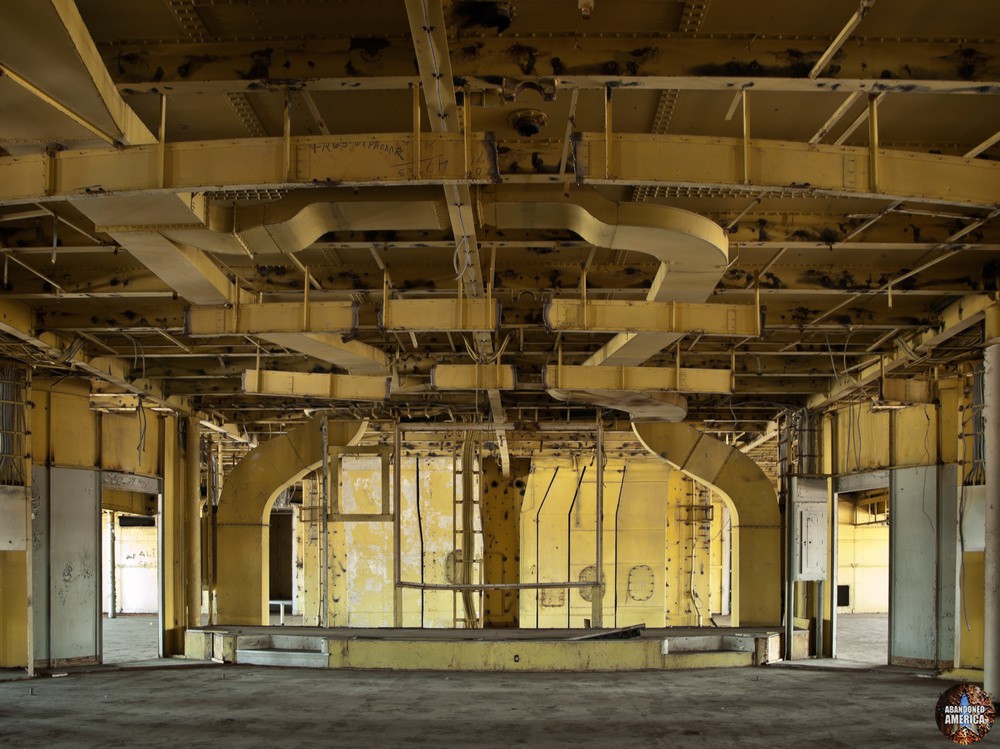
👉 Join Abandoned America on Patreon for high quality photos & exclusive content 👉 Make a one-time donation to help keep the Abandoned America project going 👉 Listen to the new Abandoned America podcast 👉 Subscribe to our mailing list for news and updates


Also in: SS United States
- LGBTQ+ History
- Women's History
- Collections
Champagne Glass, SS United States
This champagne glass was among the 57,000 pieces of glassware furnished to the SS United States before its maiden voyage in 1952. Launched in 1952, the “Big U,” as the ship was affectionately called, was 990 feet long, about the length of five city blocks. On its maiden voyage, the ship broke the speed records for crossings in both directions and captured the Blue Riband trophy, an award for the ship making the fastest round trip passage on the North Atlantic. The time set by the United States on the westbound leg from New York to England was 3 days, 12 hours, and 12 minutes, with an average speed of 34.51 knots, a record that remains unbroken.
The SS United States was built in Newport News, Virginia, and was the largest and fastest transatlantic passenger liner ever built in the country. The ship had 695 staterooms located on eight of the liner’s 12 decks. It could accommodate 1,972 passengers in first, cabin, or tourist class. Some 1,011 crew were required to run the ship and serve the passengers.
Date Made: 1952
Associated Place: Atlantic Ocean
Related Event: Postwar United States
See more items in: Work and Industry: Maritime , Food , Transportation , On the Water exhibit
Exhibition: On the Water
Exhibition Location: National Museum of American History
Related Web Publication: http://americanhistory.si.edu/onthewater
Related Publication: On the Water online exhibition
Credit Line: Transfer from US Department of Commerce, Maritime Administration (through R.J. Blackwell)
Data Source: National Museum of American History
Id Number: TR.335564.02A Catalog Number: 335564.2 Accession Number: 1978.2219
Object Name: glass, champagne Other Terms: glass, champagne; Maritime
Physical Description: glass (overall material) Measurements: overall: 5 in x 3 3/4 in; 12.7 cm x 9.525 cm
Metadata Usage: CC0
Guid: http://n2t.net/ark:/65665/ng49ca746a6-5ac8-704b-e053-15f76fa0b4fa
Record Id: nmah_842139
Our collection database is a work in progress. We may update this record based on further research and review. Learn more about our approach to sharing our collection online .
If you would like to know how you can use content on this page, see the Smithsonian's Terms of Use . If you need to request an image for publication or other use, please visit Rights and Reproductions .

15+ Amazing Facts About The World's Most Astonishing Aircraft Carriers
Posted: May 31, 2024 | Last updated: May 31, 2024
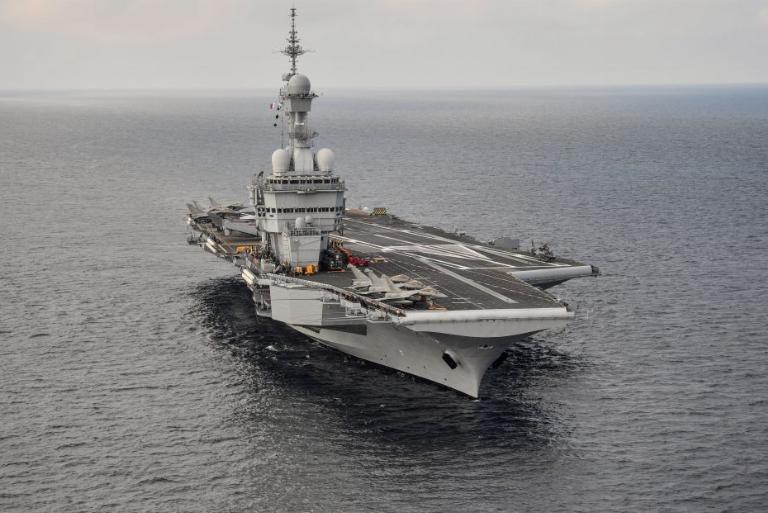
An aircraft carrier is a type of massive warship that acts as an airbase on the water. Their job is to house, arm, and deploy aircraft along with sailors and soldiers. First used in the early twentieth century to launch balloons, today, many are nuclear-powered and carry all different kinds of aircraft and supplies. There are 47 active aircraft carriers in the world operated by 14 different navies.
Just keep on reading to see the power and size of the biggest ones in the world! Let's take a look at these stunning marvels of engineering.
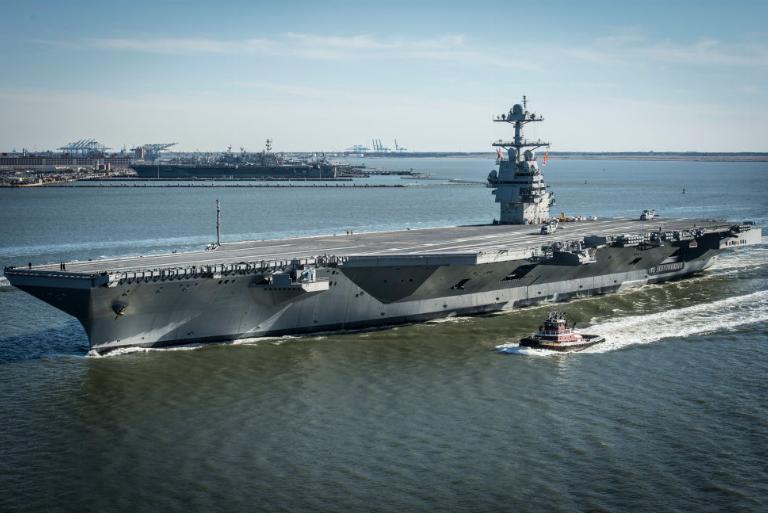
Gerald R Ford Class: United States
Owned by the United States Navy, the Gerald R For Class is one of the biggest aircraft carriers in the world. Delivered in May 2017, it is expected the second ship of this class to be operational by 2025. Its flight deck is 78 meters wide and has state-of-the-art electromagnetic systems to help planes both take off and land.
The carrier is operated by 4,539 personnel and has the capacity to carry more than 75 aircraft. On top of that, it is equipt with Rolling Airframe Missiles, Phalynx close-in-weapons systems, and RIM-162 Evolved Sea Sparrow missiles.
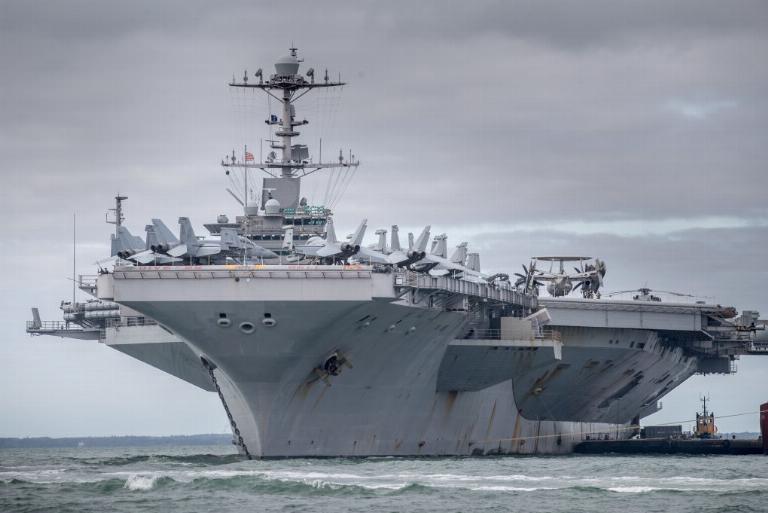
Nimitz Class: United States
The Nimitz Class is a massive ship with the first of its class being put into commission in May 1975. There are ten of them in total with the last being deployed in January 2009. Each of the ships is given a lifetime of 50 years with each expected to have at least one mid-life overhaul.
It can carry around 97,000 tons, which equates to around 60 aircraft. With 3,200 sailors, 1,500 airmen, and 500 other crew, the ship reaches 20 stories above sea level. Powered by two nuclear reactors, the ship can reach a speed of 30 knots.
Read More: Size Comparison Pics That Will Make You Realize How Small We Are
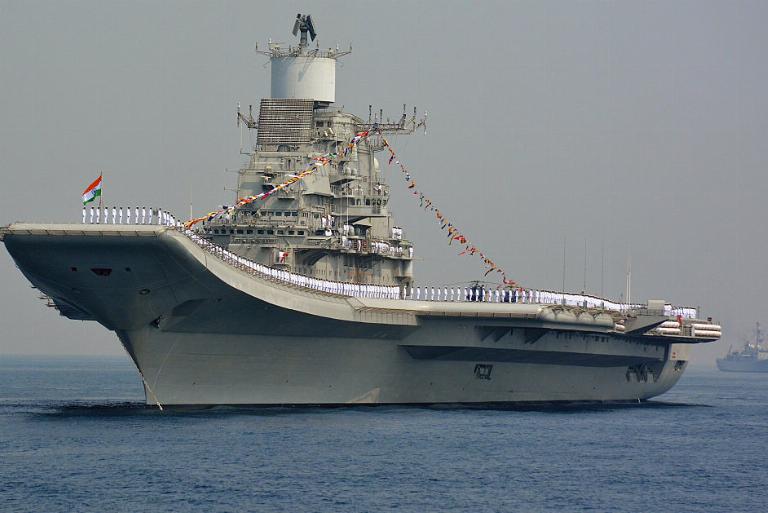
INS Vikramaditya: India
Translated to mean "brave as the Sun" and named after a famous emperor, the INS Vikramaditya is a modified Kiev-class carrier. India acquired it from Russia in 2004 for $2.35 billion and it was commissioned into service in 2013. The carrier has a displacement of 44,5000 tons and a relatively short flight deck measuring 264 meters long and 60 meters wide.
It can carry up to 30 aircraft and its weaponry includes anti-ship missiles, guided bombs and rockets, and air-to-air missiles. The ship is powered by eight turbo-pressurized boilers and four geared steam turbines.

USS John C. Stennis: United States
Docked at the Naval Base Kitsap in Washington, the carrier is named after former Senator John Stennis and is commonly referred to as "Johnny Reb." Commissioned in 1995, it served in Operation Enduring Freedom as well as pirate hunting in the Persian Gulf.
With a flight deck of 333 meters and able to carry 90 aircraft, 3,200 sailors and 2,480 airmen, it's an impressive carrier. So remarkable in fact, that it was featured in numerous different Transformers films.
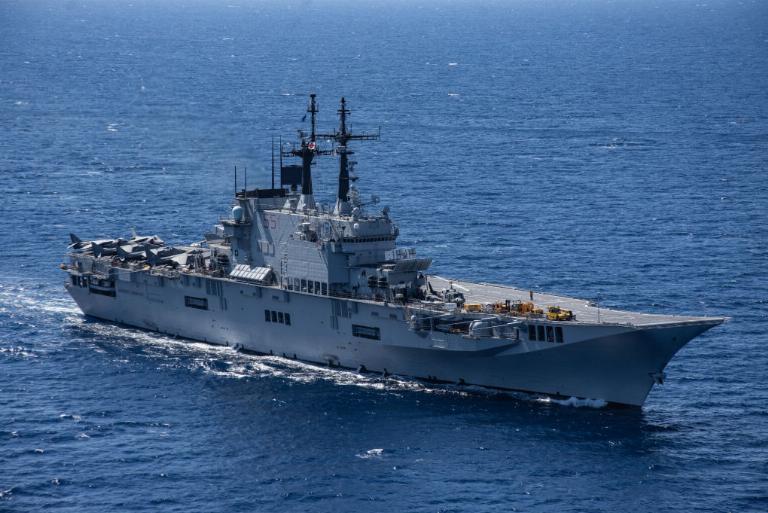
Giuseppe Garibaldi: Italy
Italy's first aircraft carrier, the Giuseppe Garibaldi was commissioned in 1985 and specializes in carrying Harrier II fighters and AgustaWestland EH101 helicopters. So far, it has been used in combat air operations in Somalia, Kosovo, Afghanistan, and Libya.
During the first year of the War in Afghanistan, the planes housed on the Garibaldi carried out 288 missions, dropping 160 guided missiles during the NATO Libya mission. However, the carrier isn't as large as most United States ships, with a flight deck of only 180 meters and carrying under 1,000 personnel. However, it is fast with four gas turbines and six diesel generators.
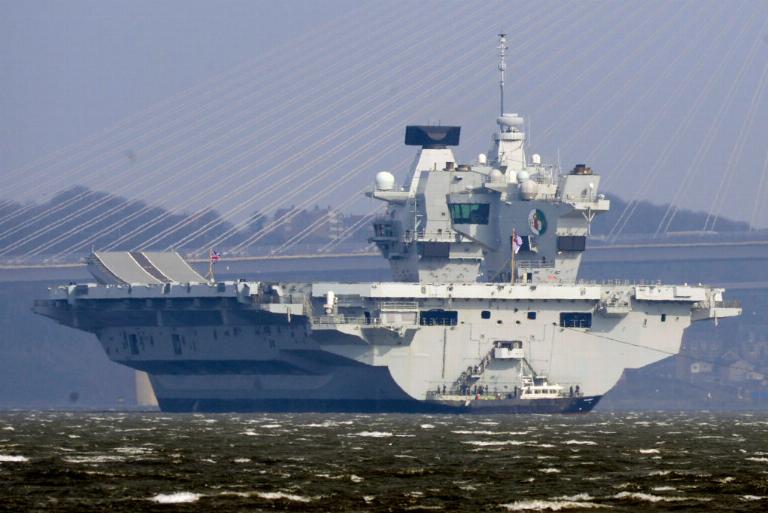
Queen Elizabeth Class: United Kingdom
The largest aircraft carriers in the British Navy are known as the Queen Elizabeth Class. The first of her kind is the HMS Queen Elizabeth which began testing in 2017 and entered service in 2020. The second of its class, the HMS Prince of Whales, began sea trials in 2019 and was fully operational in October 2021.
Only needing a small crew of 679 to operate, they are two of the most technologically advanced carriers in the world. They are powered by two Rolls-Royce MT30 gas turbines and four diesel generators.
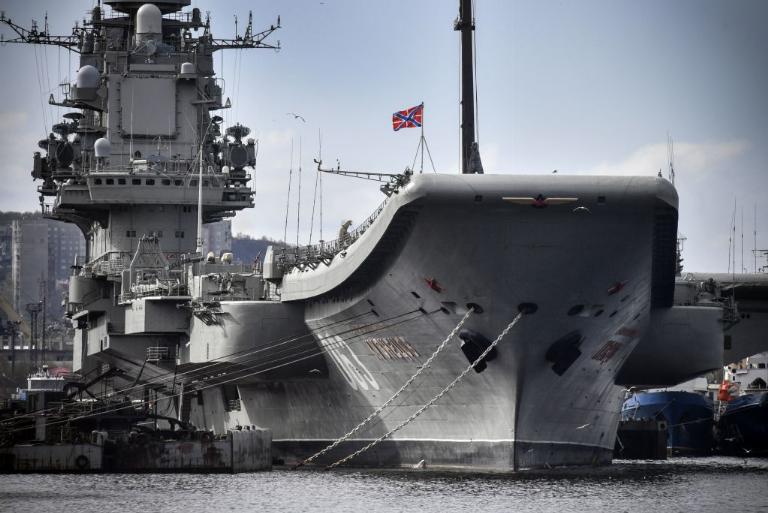
Admiral Kuznetsov: Russia
Surprisingly, the Russian Navy only has one aircraft carrier. The Admiral Kuznetsov can carry Su-25UTG/UBP STOVL and Su-33, MiG-29K fighters, including 27LD32 and Ka-27 PLO helicopters. It can also hold 1,960 crewmen, 40 flagstaffs, and 626 air group.
The carrier has no shortage of weaponry either and is equipt with AK-630 AA guns, CADS-N-1 Kashtan CIWS, RBU-12000 UDAV-1 ASW rocket launchers, and P-700 Granit anti-ship cruise missiles. It was first launched in 1985 and was fully operational by 1995.
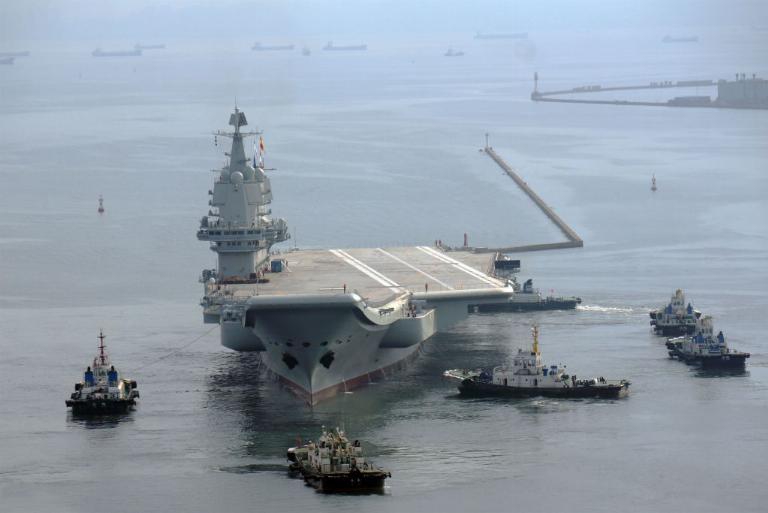
Liaoning(16): China
Interestingly, the Liaoning(16) carrier was initially deployed as part of the Admiral Kuznetsov Class for the Soviet Union. Yet, in 1998, the Hong Kong-based Chong Lot Travel Agency bought the carrier with plans to convert it into a casino, although it never happened.
After the dissolution of the Soviet Union, it was brought back to Ukraine and then bought once again by China's Navy to serve as an aircraft carrier. Put into service in 2012, it can hold around 50 aircraft and is powered by steam turbine propulsion.
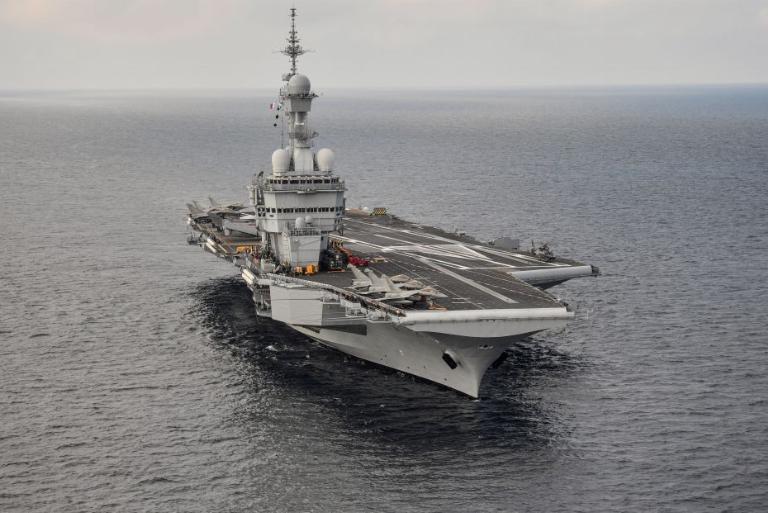
Charles de Gaulle (R91): France
Regarded as the flagship of the French Navy and the largest in Western Europe, the Charles de Gaulle is the only nuclear-powered carrier not owned by the United States Navy. It can fit 40 fixed-wing aircraft and helicopters such as Rafale M, Super Étendard, E-2C Hawkeye, SA365 Dauphin, EC725 Caracal, and AS532 Cougar.
It has a full-load displacement of 42,000 tons and houses 1,350 crewmen and 600 airmen. Being nuclear-powered it can reach a speed of 27 knots.
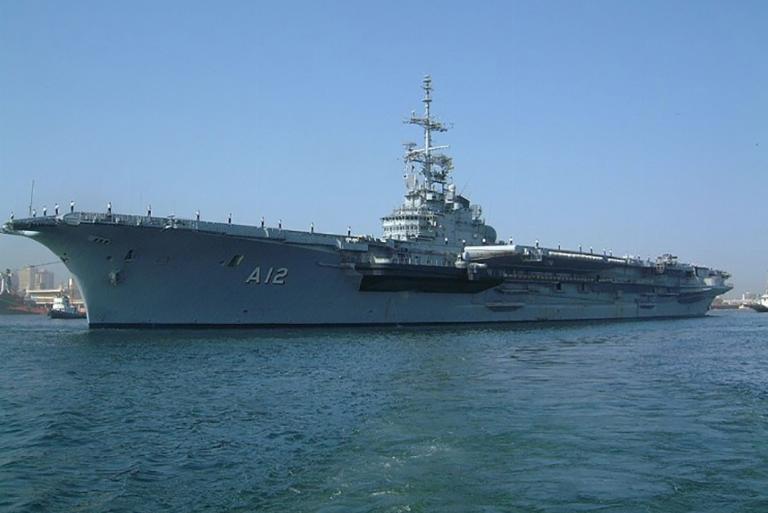
São Paulo (A12): Brazil
Decommissioned in 2017, the São Paulo was a Clemenceau-Class aircraft that was in service with the Brazilian Navy. Originally, it was commissioned by the French Navy as Foch but traded hands to Brazil in 2000. Unfortunately, the ship had some service issues and never went more than three months without needing repairs.
The flight deck could handle 39 aircraft including fixed-wing, fighters, and helicopters. The ship was propelled by six boilers which allowed it to reach 32 knots.
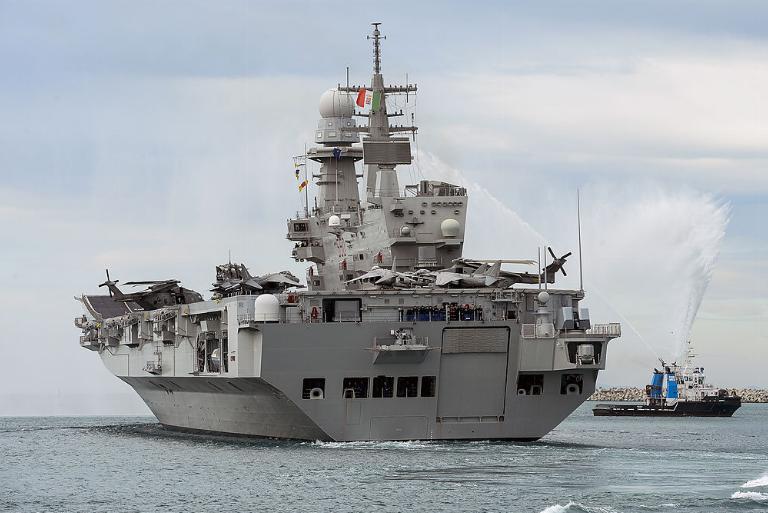
Cavour (550): Italy
Launched in 2004, the Cavour is the flagship of the Italian Navy, designed to carry out fixed-wing and helicopter air operations, as well as transporting military, civil personnel, and heavy vehicles. Its hangar can hold up to 24 main battle tanks and some extra light vehicles.
It has a load displacement of 30,000 tons with a flight deck that's 323.6 meters long and 34.5 meters wide. The carrier also has an extensive defense system which includes short-range defense weapons, as well as guns and decoy launchers.

The USS George H.W. Bush: United States
The USS George H.W. Bush is nicknamed "The Avenger" after the plane that H.W. Bush flew during World War II. The ship was delivered in May 2009 and served during Operation Enduring Freedom in Iraq and in 2014 was the first to launch air strikes against ISIS.
The carrier displaces over 100,000 tons and the flight deck measures 333 meters in length. Powered by nuclear reactors, she can operate for more than 20 years without refueling and can reach speeds well over 30 knots.
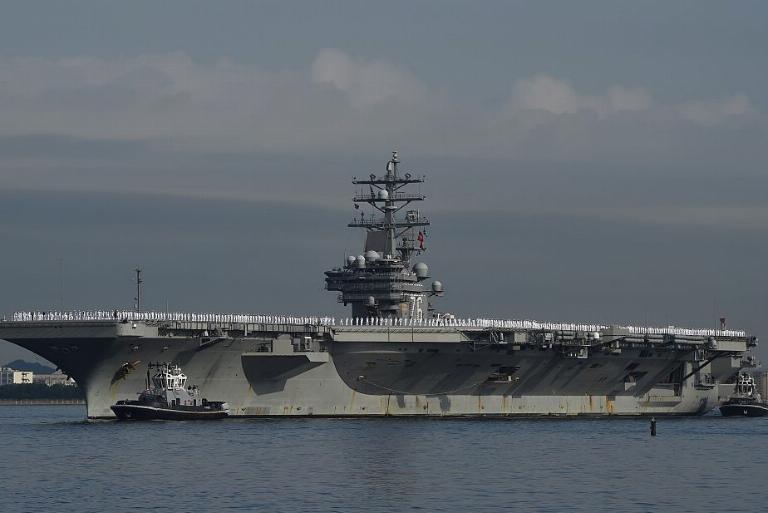
The USS Ronald Reagan: United States
Currently stationed at Yokosuka Naval Base in Japan, the USS Ronald Reagan was commissioned and ready for action in the Persian Gulf by 2006. It served during Operation Iraqi Freedom, Operation Enduring Freedom, as well as provided aid after the 2011 earthquake in Japan.
It has the capacity to house 90 aircraft as well as 3,200 sailors and 2,480 airmen. The ship is powered by 2 Westinghouse A4W nuclear reactors on top of 4 steam turbines.
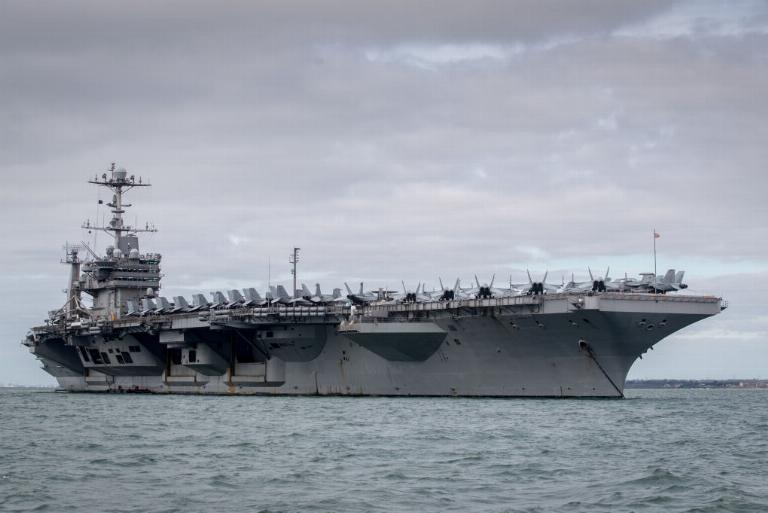
USS Harry S. Truman: United States
Also known as the "Truman," "HST," or "Lone Warrior," the USS Truman was first launched in 1996 and was part of the enforcement squad for the no-fly zone over Bosnia. It then went on to serve during Operation Southern Watch and flew 1,300 sorties during Iraqi Freedom.
As tall as a 24-story building, the ship's flight deck is 333 meters long and can carry 90 various types of aircraft. Using A4W nuclear reactors, the ship can travel over 3 million miles before refueling. It also helps that it has four five-bladed propellors that weigh 66,220 pounds each.
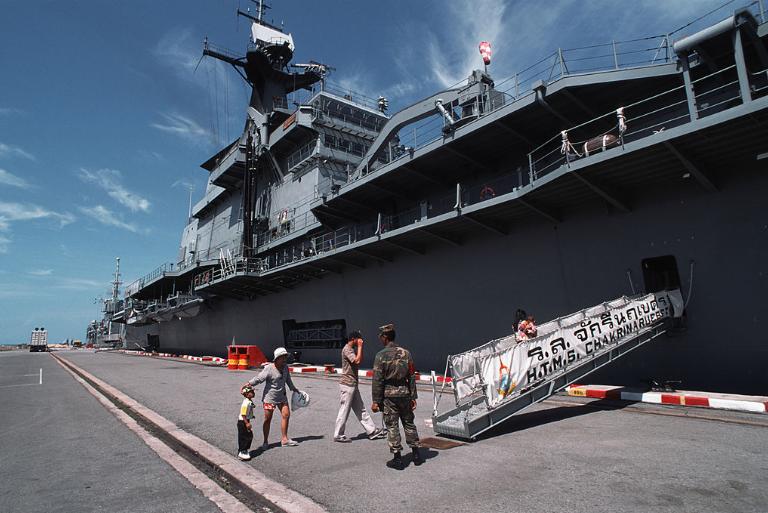
HTMS Chakri Naruebet: Thailand
A bit on the smaller side than some other carriers, the HTMS Chakri Naruebet is Thailand's only aircraft carrier. Commissioned in 1997, it spends most of its time docked, although it has been deployed on a series of disaster relief missions.
It is frequently used as transportation for the Royal Family of Thailand yet the navy still trains with it once a month. With a flight deck of only 600 feet, it can carry 4 to 6 S-70B Seahawk helicopters and up to 675 soldiers.
USS George Washington: United States
Commissioned in 1992, the USS George Washington served in the Persian Gulf in 2000 and provided airspace defense after the September 11 attacks in 2001. The ship was also involved in Operation Southern Watch and Operation Enduring Freedom.
Since it is currently stationed in Yokosuka, Japan, the US Navy created a 200-page manga to help explain what an aircraft carrier is to the Japanese people. It's a large carrier that can handle 90 aircraft, has a flight deck of 330 meters, and houses around 5,680 individuals. It is powered by two Westinghouse A4W nuclear reactors, and four steam turbines.
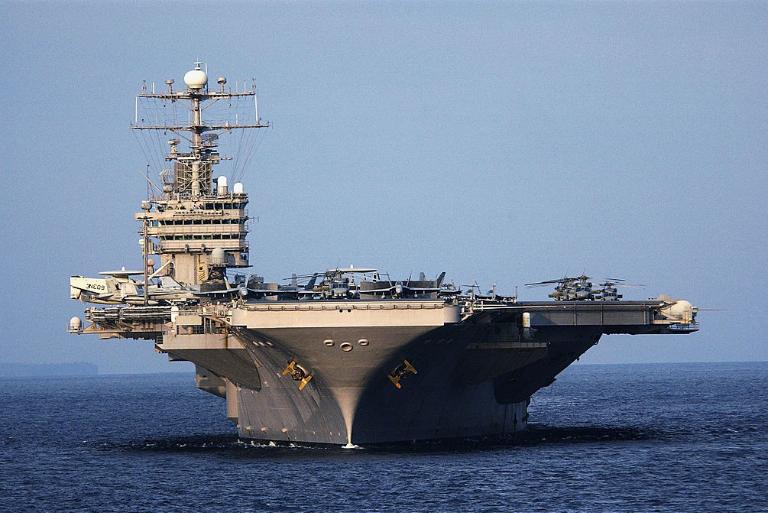
USS Abraham Lincoln: United States
Nicknamed "Abe," the USS Abraham Lincoln was first used for relief services in the Philippines after the eruption of Mt. Pinatubo in 1991. It helped get over 45,000 people off of the island and is also the first aircraft carrier to fully integrate female airmen.
The ship has the ability to carry 90 aircraft and over 5,500 personnel, returning to active duty after four years of refueling and adjustments. It is also the same carrier that President George W. Bush gave his speech in front of the "Mission Accomplished " accomplished banner.
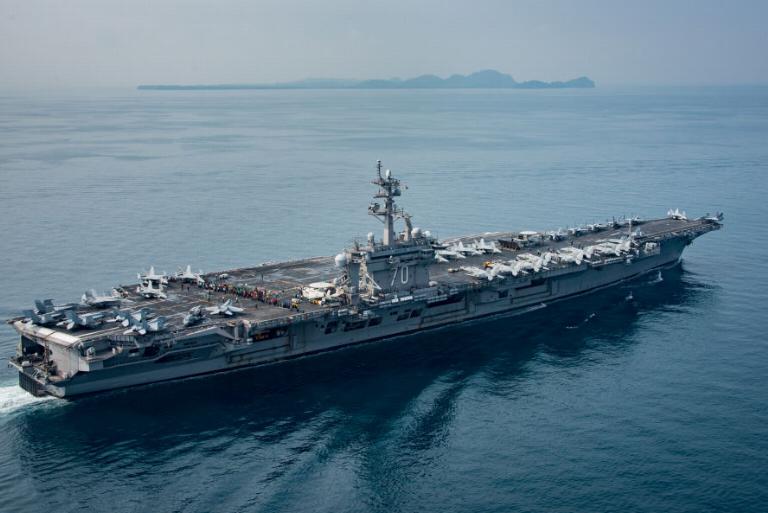
USS Carl Vinson: United States
The USS Carl Vinson is named after the former congressman from Georgia who was in office during World War II and brought the Departments of War and the Navy into a a single Department of Defense.
Also referred to "The Gold Eagle," "Starship Vinson," and the "Battlestar," it was the aircraft carrier that deposited Osama bin Laden's body at seas and has even hosted NCAA basketball games. Carrying up to 90 planes, the ship was used to battle ISIS in 2013 with its planes dropping over 230 tons on bombs on ISIS positions.
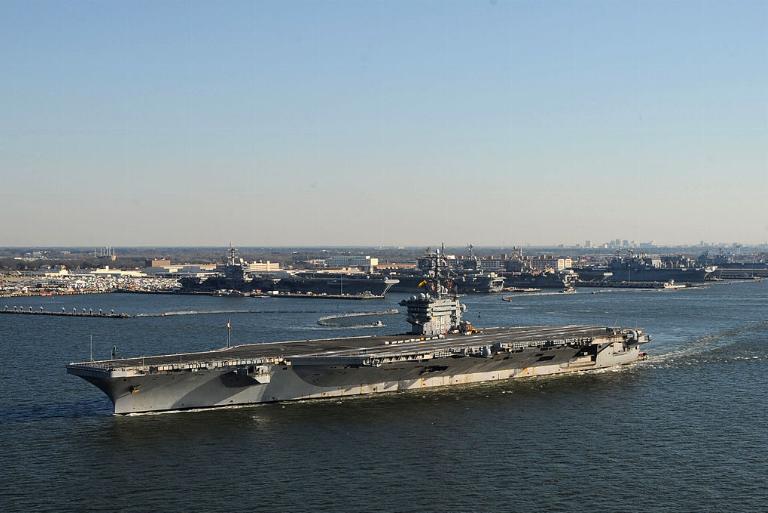
USS Dwight D. Eisenhower: United States
Also known as "Mighty Ike," the USS Dwight D. Eisenhower served during the operation Eagle Claw during the Iranian Hostage Crisis. Commissioned in 1977, it secured Iraqi airspace in 2003 and went through the Suez Canal during Desert Storm.
After some time, the ship and its aircraft were put to use again to fight against ISIS, dropping over 1,100 bombs in Iraq and Syria. Currently, the ship is docked at Naval Station Norfolk in Virginia.
Read More: Scientists Make A Discovery, Unlock Secrets About Ancient Human DNA
More for You
Donald Trump Handed Election Loss In Texas
The Forgotten '60s Sitcom That Kicked The Twilight Zone Off TV
Stephen Hawking once gave a simple answer as to whether there was a God
New Air Force wing in Arizona gets nod from state lawmakers
10 Fast-Food Sandwiches From the ’80s That Have Vanished
Startup unveils hydrogen-powered VTOL aircraft — and it could revolutionize aviation
Stephen King Election Remark Takes Internet By Storm
Ranking the Four AFC West Quarterbacks
The 3 Dirtiest Body Parts People Forget To Wash Properly
23 Employees Who Messed Up So Badly At Work, I Have NO Clue How They Got Away With It
Jennifer Lopez cancels 2024 tour This Is Me: 'Completely heartsick and devastated'
Caitlin Clark at Risk of WNBA Suspension for Recent Conduct
A retired couple sold their home to live on a cruise ship. This is how much they're saving
International reaction to Donald Trump's criminal conviction
Yellowstone Spinoff, 1923, Gets Major Filming Update
'Hogan's Heroes': The Cast Through The Years
Video Shows Joe Biden 'Sleeping' During Memorial Day Speech
Zelenskyy on Gripen: Pilots must start training now to avoid wasting time
What one man learned living alone in the wilderness for 40 years
Speaker Mike Johnson calls for Supreme Court to ‘step in’ after Trump’s historic conviction

IMAGES
VIDEO
COMMENTS
SS United States is a retired ocean liner built between 1950 and 1951 for United States Lines. She is the largest ocean liner constructed entirely in the United States and the fastest ocean liner to cross the Atlantic in either direction, ... 524 cabin, and 554 tourist-class passengers.
However when the America was launched in 1939 class distinction on ships was quite rigid with strict separation between First Cabin and Tourist. The only exception was an occasional adventurous small child would break out of the confines of Tourist by sliding under the locked gates. United States lines described Tourist class as a ...
TOURIST CLASS. United States lines described tourist class on the SS United States as a "…Convenience to those who are economy-minded, and desire to obtain the best possible value in ocean travel, for a limited expenditure…" Value travelers frequently included students (Bill Clinton on his way to Oxford), immigrants on a limited budget ...
GET TO KNOW THE S.S. UNITED STATES DECK BY DECK. Click on the above cutaway diagram to see the ship broken down by class of passenger accommodation. Click on the above cutaway diagram to see the ship broken down according to our restoration and adaptive reuse plan. Click here to read a breakdown of the restoration plan.
904 first class, 524 Cabin, 554 Tourist = 1,982 - crew; From breakfast to late night buffet the galleys turned out 9,000 meals per day; ... In 1954, the minimum first-class fare on the SS United States from New York to Southampton was $365 ($3,783 in 2022). For that price, passengers sailed on a floating luxury resort offering the refinement ...
The 53,330-gross tonne SS United States was the grand dame of ocean liners during her 17-year career from 1952 to 1969. She was stately, with 12 decks and an overall length of 990 feet (302 metres) or more than 100 feet longer than the RMS Titanic. From keel to funnel, she was just at tall at 175 feet (53 metres).
First Class fare to Southampton in 1951 was $295.00 and up in First Class, $200.00 in Cabin, and $160 in Tourist. For that price passengers sailed on a floating luxury resort offering the refinement and conveniences of the finest American hotel. They enjoyed expansive deck space and elegant public rooms.
Passengers boarding the United States received a warm welcome, especially if they were the King and Queen of Greece. (above). * Peter Crome. Step aboard for a first-class sailing experience. In 1954, the minimum first-class fare on the SS United States from New York to Southampton was $365 ($3,783 in 2022). For that price, passengers sailed on ...
Blue Riband. Advance publicity for the SS United States had primed the American public for a record-breaking vessel. Secrecy was tight during the builder's trials in June of 1952, but it was later learned that the vessel exceeded 38 knots, or 44 miles per hour. She traveled 20 knots in reverse. On July 3rd, 1952, the SS United States set ...
I crossed the Atlantic twice on the S.S. United States. Once in 1957 and again in 1960. My father was in the military, an officer, so we had the privilege of traveling first class. Even though I was only a young boy, I still remember the awe of transatlantic travel. It was an experience unlike any other, before or after.
1 of 18. CNN —. At the age of 10, David Macaulay immigrated to America from England in 1957 with his mother, brother, and sister aboard the SS United States - a massive, gleaming ocean liner ...
Travel A photo tour of the SS United States Published 6:57 AM EST, Tue December 15, 2020 Link Copied! Pride of the oceans: The liner SS United States was a record breaker. In 1952 she took the ...
In 1952 the United States Lines advertised the July 3 maiden voyage of the new SS UNITED STATES. First Class fares started at $350 or $70 a night including deluxe accommodations, meals and transportation from New York to Europe. Similar accommodations on any trans-Atlantic ship today would be way over $350 a night. ... Both ships had tourist ...
I crossed the Atlantic twice on the S.S. United States. Once in 1957 and again in 1960. My father was in the military, an officer, so we had the privilege of traveling first class. Even though I was only a young boy, I still remember the awe of transatlantic travel. It was an experience unlike any other, before or after.
It always strikes this tourist as a bit strange - the sudden disparity between first and cabin-class and tourist class facilities on a ship flying the flag of the United States, which is supposedly a land without sharp class distinction of the old world. Paul Friedlander, SS United States review, New York Times, June 29, 1952.
The S.S. United States will be taking her builder's trials and acceptance trials preparatory to entering the deluxe transatlantic trade on July 3. ... in tourist class—554 passengers—the ...
The S.S. United States was taken out of service in 1969 and is currently docked at Pier 82 in Philadelphia. Structurally sound, the ship is maintained by the S.S. United States Conservancy, a not-for-profit dedicated to the reuse and redevelopment of the liner. S.S. United States at Pier 82, Philadelphia, PA
To the man in charge of the SS United States first-class dining room, the competition for passengers was won or lost at the dining table. "Given that superliners are all pretty luxurious and they take about the same amount of time to cross." According to Arch Mundy Maître D on the United States, "The only competition between passenger ships is based on service and food."
A new dawn may be coming to the SS United States, the fastest ocean liner ever, which has been tied up at a pier in Philadelphia since 1996.The ship is 990 feet long, more than a hundred feet ...
SS United States. There is little left of the tourist class theater that indicates the once stylish decor. Because stone or metal would add to her weight, all adornments had to be light. William Francis Gibbs, the SS United States' architect and engineer, was terrified of the prospect of a devastating fire at sea, and so very little wood was ...
The SS United States was built in Newport News, Virginia, and was the largest and fastest transatlantic passenger liner ever built in the country. The ship had 695 staterooms located on eight of the liner's 12 decks. It could accommodate 1,972 passengers in first, cabin, or tourist class.
Cabin Class. Beluga Malossol Caviar, Canape or Smoked Irish Salmon. Roast Maryland Turkey, Chestnut Stuffing, Giblet Gravy, Cranberry Jelly. Baked Sugar-cured Yorkshire Ham, Pineapple Sauce. Prime Cut Sirloin Steaks, Mushrooms Sauce. Clara Barton Salad, Special Dressing. Strawberry Sundae Petits Fours.
SS Washington was a 24,189-ton luxury liner of the United States Lines, named after the US capital city.On 6 June 1941, the Washington was commissioned as the troopship USS Mount Vernon.In 1947 one deck was restored to prewar condition and the ship resumed commercial service. In 1951 the ship was again used by the U.S. Government transporting soldiers and their families.
Owned by the United States Navy, the Gerald R For Class is one of the biggest aircraft carriers in the world. Delivered in May 2017, it is expected the second ship of this class to be operational ...
A version of this story appears in CNN's What Matters newsletter. To get it in your inbox, sign up for free here. The US Constitution lays out just three requirements for presidential candidates ...